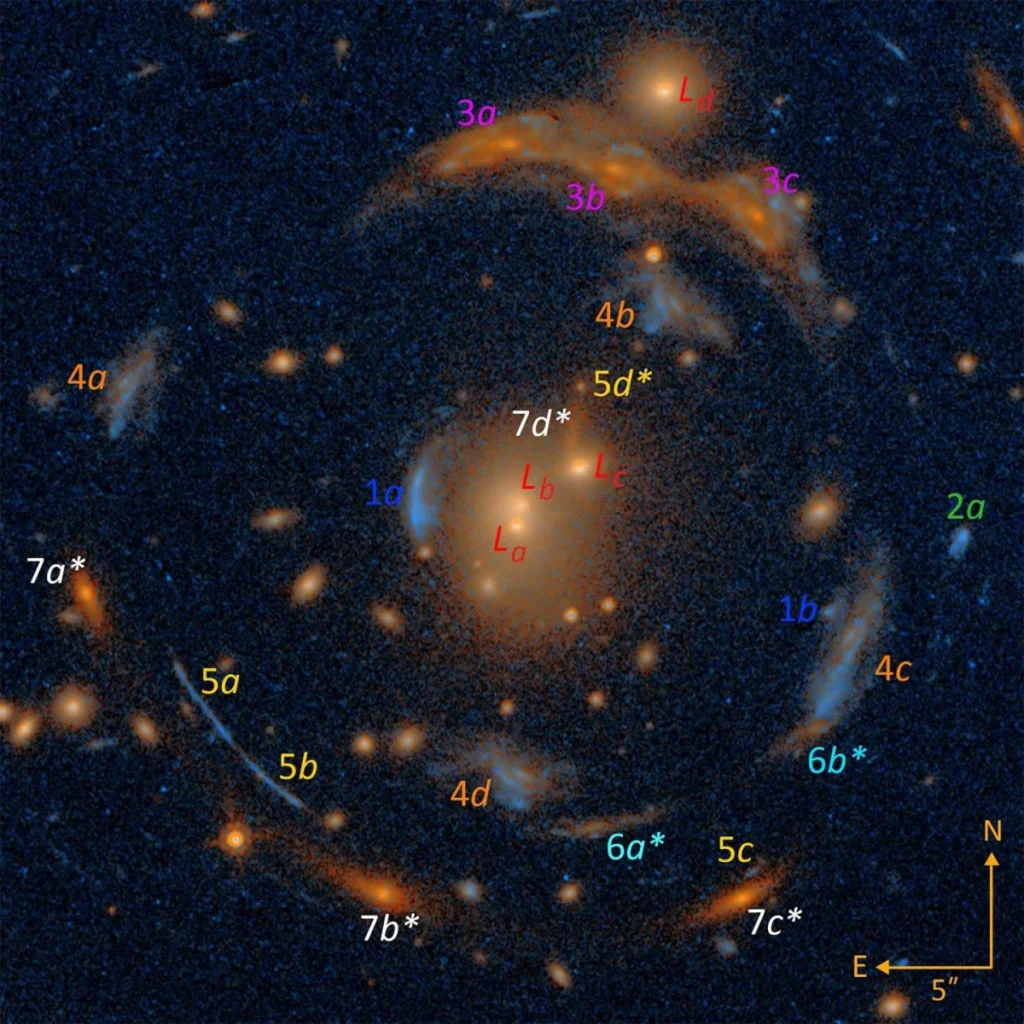Gravitational lensing is one of the most powerful natural tools that astronomers use to peer deeper into the cosmos. Recently, researchers uncovered a remarkably aligned gravitational lens system, known as the Carousel Lens. Let’s unravel the mysteries behind this cosmic phenomenon and explore why this discovery is so important for our understanding of the universe.
The Discovery of the Carousel Lens
The Carousel Lens is not just any gravitational lens; it’s an extraordinary cosmic arrangement involving a unique alignment of a massive galaxy cluster and multiple background galaxies. This configuration creates a powerful lens that magnifies and distorts light from galaxies billions of light-years away, providing a clearer view of the universe’s hidden elements. This discovery was made possible through data from NASA’s Hubble Space Telescope and the DESI Legacy Imaging Surveys, highlighting the intricate alignment that researchers have compared to finding “eight needles precisely lined up inside a haystack.”

The lens consists of a massive foreground cluster located five billion light-years away, with seven background galaxies positioned between 7.6 and 12 billion light-years from Earth. The gravitational pull of the foreground cluster warps the surrounding space-time, bending the light from the background galaxies into multiple distorted images. This cosmic “fun-house mirror” effect is more than visually captivating—it’s scientifically transformative, enabling astronomers to probe the universe’s most fundamental forces.
Unraveling the Structure of the Universe
The Carousel Lens provides a new way to study the universe’s structure by enhancing our view of distant galaxies and magnifying previously unseen details. Gravitational lensing allows scientists to map the invisible dark matter that permeates the cosmos. As light from distant galaxies travels through the warped space-time around the lensing cluster, it bends, magnifies, and reveals details that would otherwise be hidden. This not only helps researchers visualize the universe’s structure but also offers new ways to study dark matter and dark energy.
Dark matter does not emit light, making it impossible to observe directly. However, its presence can be inferred through its gravitational influence, as seen in the distorted images of background galaxies through lenses like the Carousel Lens. This system acts as a magnifying glass that allows researchers to study dark matter’s distribution and its role in shaping the universe. Moreover, these lenses offer a unique opportunity to explore dark energy, the mysterious force driving the accelerated expansion of the universe.
Implications for Dark Matter and Dark Energy
The Carousel Lens is much more than a cosmic spectacle; it’s a crucial tool for unraveling the mysteries of dark matter and dark energy. One of the most intriguing features of this lens is the presence of an Einstein Cross—the largest observed to date—surrounding one of the background galaxies. This rare formation, where a single galaxy appears as four distinct images around the lens, indicates a symmetrical distribution of mass dominated by dark matter.
The Einstein Cross is significant because it allows scientists to model the mass distribution of the lensing cluster with high precision. This helps researchers understand how dark matter is structured within the cluster and provides critical data for studying dark energy’s influence on the universe’s expansion.
Insights From the Research Process
The discovery of the Carousel Lens was a triumph of advanced observational and computational techniques. Using data from Hubble and DESI Legacy Imaging Surveys, along with the computational power of the Perlmutter supercomputer at the National Energy Research Scientific Computing Center (NERSC), researchers identified strong lens candidates and meticulously modeled their gravitational effects.
According to Xiaosheng Huang, a study co-author and member of Berkeley Lab’s Supernova Cosmology Project, “The Carousel Lens is an incredible alignment of seven galaxies in five groupings that line up nearly perfectly behind the foreground cluster lens.” This precision alignment offers a rare opportunity to examine how light behaves under extreme gravitational influences, providing new insights into the universe’s underlying structure.
The Future of Research with the Carousel Lens
The Carousel Lens sets the stage for groundbreaking research into dark matter, dark energy, and the universe’s large-scale structure. Future studies will focus on using this unique lens system to refine models of dark matter distribution and investigate the properties of dark energy with greater accuracy. The lens’s precise configuration provides a valuable testing ground for theories of cosmic evolution and offers new pathways for exploring fundamental forces that govern the universe.
Furthermore, the methodologies developed through this research can be applied to other lensing systems, enhancing our ability to identify and study gravitational lenses in different cosmic environments. By building on the success of the Carousel Lens, scientists hope to uncover additional lensing systems that could reveal even more about the universe’s hidden dynamics.
Reference:
Sheu, W., Cikota, A., Huang, X., Glazebrook, K., Storfer, C., Agarwal, S., Schlegel, D. J., Suzuki, N., Barone, T. M., Bian, F., Jeltema, T., Jones, T., Kacprzak, G. G., O’Donnell, J. H., & Vasan, K. G. C. (2024). The Carousel Lens: A well-modeled strong lens with multiple lensed sources.



















